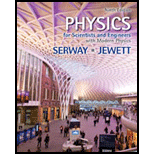
Concept explainers
(a) Show that the rate of change of the free-fall acceleration with vertical position near the Earth’s surface is
This rate of change with position is called a gradient.
(b) Assuming h is small in comparison to the radius of the Earth, show that the difference in free-fall acceleration between two points separated by vertical distance h is
(c) Evaluate this difference for h = 6.00 m, a typical height for a two-story building.
(a)
To show: The rate of change of free fall acceleration with vertical position near the Earth’s surface is
Explanation of Solution
Explanation:
The rate of change free fall acceleration with position of any quantity is called gradient. And the free fall acceleration is the acceleration of a body falling freely in a vacuum near the surface of the Earth. it is also called as acceleration due to gravity.
Formula to calculate the acceleration due to gravity at distance
The differentiate for the above equation with respect to
The distance
Conclusion:
Therefore, the rate of change of free fall acceleration with vertical position near the Earth’s surface is
(b)
To show: The difference in free fall acceleration with between two points separated by vertical distance
Explanation of Solution
Explanation:
The force that attracts a body towards the center of the Earth, or towards any other physical body having mass called as gravity.
Formula to calculate the difference in free fall acceleration between two points is,
Formula to calculate the acceleration due to gravity at the Earth surface is,
Formula to calculate the acceleration due to gravity at a vertical distance
Substitute
The distance
Conclusion:
Therefore, the difference in free fall acceleration with between two points separated by vertical distance
(c)
To determine: The difference in free fall acceleration between two points separated by vertical distance
Answer to Problem 62AP
Answer: The difference in free fall acceleration between two points separated by vertical distance
Explanation of Solution
Explanation:
From equation (II),
Substitute
Conclusion:
Therefore, the difference in free fall acceleration with between two points separated by vertical distance
Want to see more full solutions like this?
Chapter 13 Solutions
Physics for Scientists and Engineers With Modern Physics
- Suppose the gravitational acceleration at the surface of a certain moon A of Jupiter is 2 m/s2. Moon B has twice the mass and twice the radius of moon A. What is the gravitational acceleration at its surface? Neglect the gravitational acceleration due to Jupiter, (a) 8 m/s2 (b) 4 m/s2 (c) 2 m/s2 (d) 1 m/s2 (e) 0.5 m/s2arrow_forwardCalculate the effective gravitational field vector g at Earths surface at the poles and the equator. Take account of the difference in the equatorial (6378 km) and polar (6357 km) radius as well as the centrifugal force. How well does the result agree with the difference calculated with the result g = 9.780356[1 + 0.0052885 sin 2 0.0000059 sin2(2)]m/s2 where is the latitude?arrow_forwardIf a spacecraft is headed for the outer solar system, it may require several gravitational slingshots with planets in the inner solar system. If a spacecraft undergoes a head-on slingshot with Venus as in Example 11.6, find the spacecrafts change in speed vS. Hint: Venuss orbital period is 1.94 107 s, and its average distance from the Sun is 1.08 1011 m.arrow_forward
- Estimate the gravitational force between two sumo wrestlers, with masses 220 kg and 240 kg, when they are embraced and their centers are 1.2 m apart.arrow_forwardWhat is the orbital radius of an Earth satellite having a period of 1.00 h? (b) What is unreasonable about this result?arrow_forwardIn Example 2.6, we considered a simple model for a rocket launched from the surface of the Earth. A better expression for the rockets position measured from the center of the Earth is given by y(t)=(R3/2+3g2Rt)2/3j where R is the radius of the Earth (6.38 106 m) and g is the constant acceleration of an object in free fall near the Earths surface (9.81 m/s2). a. Derive expressions for vy(t) and ay(t). b. Plot y(t), vy(t), and ay(t). (A spreadsheet program would be helpful.) c. When will the rocket be at y=4R? d. What are vy and ay when y=4R?arrow_forward
 Classical Dynamics of Particles and SystemsPhysicsISBN:9780534408961Author:Stephen T. Thornton, Jerry B. MarionPublisher:Cengage Learning
Classical Dynamics of Particles and SystemsPhysicsISBN:9780534408961Author:Stephen T. Thornton, Jerry B. MarionPublisher:Cengage Learning Principles of Physics: A Calculus-Based TextPhysicsISBN:9781133104261Author:Raymond A. Serway, John W. JewettPublisher:Cengage Learning
Principles of Physics: A Calculus-Based TextPhysicsISBN:9781133104261Author:Raymond A. Serway, John W. JewettPublisher:Cengage Learning Physics for Scientists and Engineers, Technology ...PhysicsISBN:9781305116399Author:Raymond A. Serway, John W. JewettPublisher:Cengage Learning
Physics for Scientists and Engineers, Technology ...PhysicsISBN:9781305116399Author:Raymond A. Serway, John W. JewettPublisher:Cengage Learning Physics for Scientists and Engineers: Foundations...PhysicsISBN:9781133939146Author:Katz, Debora M.Publisher:Cengage Learning
Physics for Scientists and Engineers: Foundations...PhysicsISBN:9781133939146Author:Katz, Debora M.Publisher:Cengage Learning Glencoe Physics: Principles and Problems, Student...PhysicsISBN:9780078807213Author:Paul W. ZitzewitzPublisher:Glencoe/McGraw-Hill
Glencoe Physics: Principles and Problems, Student...PhysicsISBN:9780078807213Author:Paul W. ZitzewitzPublisher:Glencoe/McGraw-Hill University Physics Volume 1PhysicsISBN:9781938168277Author:William Moebs, Samuel J. Ling, Jeff SannyPublisher:OpenStax - Rice University
University Physics Volume 1PhysicsISBN:9781938168277Author:William Moebs, Samuel J. Ling, Jeff SannyPublisher:OpenStax - Rice University





